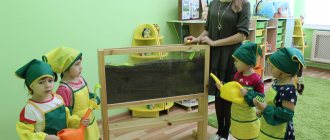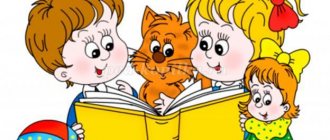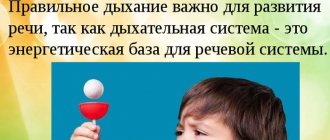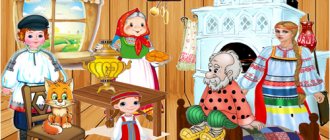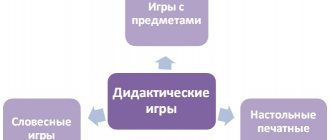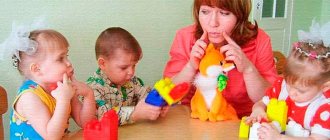A selection of didactic games and exercises for the development of figurative speech in older preschoolers.
A selection of didactic games and exercises for the development of figurative speech in older preschoolers.
1."At the exhibition".
Purpose: to describe the picture using figurative words and expressions.
Progress of the game: The teacher places children's drawings on an easel or in a group room and organizes an exhibition. Appoints a guide who conducts a tour of the exhibition. The guide must beautifully describe the paintings and give them names. If a child has difficulty with something, the children help him. The teacher regulates the frequency of tour guide changes. At the end of the game, the best tour guide is chosen.
2. “Let’s paint a picture with words.”
Goal: To develop children’s imagination, the ability to use words and figurative expressions that are accurate in meaning in descriptions.
Progress of the game: Educator: Children, do you want to become extraordinary artists who draw not with paints and pencils, but with words? Then get ready to draw. I will read you a gentle poem about winter, and you close your eyes and try to imagine what I will read about. Then tell me what kind of picture you got. But it must be told in such a way that everyone can mentally imagine this picture. Children can then paint illustrations for their stories. For this task, two fragments of the novel by A.S. are proposed. Pushkin “Eugene Onegin” and an excerpt from the poem “Winter Evening! Under blue skies Magnificent carpets Glistening in the sun, the snow lies. She came, crumbled into shreds, hung on the branches of oak trees; Lay down in wavy carpets Among the fields, around the hills. The storm covers the sky with darkness, spinning snow whirlwinds; Either she will howl like a beast, or she will cry like a child.
3. «Mystery".
Goal: identify the characteristics of objects, come up with riddles using figurative words and expressions. Material: Each player has a picture upside down. Assignment: Come up with a riddle based on the picture and tell it to everyone present. The winner is the one who comes up with the most interesting riddles, chooses comparisons, descriptions, and “beautiful” words for his riddle. Game option: Purpose: To develop imagination, the ability to expressively convey content and characters using words. An adult chooses one or two players who, using dolls, hats or other attributes, act out an episode or dialogue from a literary work. Children guess which fairy tale or story this passage is from. Whoever guesses first and says what preceded this episode, and what actions in the work will follow it, will have the right to be the first to guess the next riddle. The game is repeated several times.
4. “Who is more attentive?”
Purpose: To highlight figurative expressions and specific literary expressions in a literary text. Game rule: the one who notices and names more fairy-tale expressions and figurative words wins.
Progress of the game: Educator: Different peoples live on earth. And every nation has its own fairy tales. Folk tales can be easily distinguished from original literary works, because they contain special fairy tale words and songs. Now I will tell you a fairy tale that you already know. Listen carefully and try to notice such words. After reading a fairy tale, children name specific fairy tale expressions. Each correct answer is marked with a token.
5. “I’ll start, and you continue.”
Goal: select figurative words and expressions that are most appropriate in meaning. The teacher makes up unfinished sentences. The child must complete the sentence using figurative figures of speech. - It was a clear frosty day, snow in the sun... (sparkled, sparkled, shimmered, sparkled). - Misha sat on the sled and rushed down the mountain... (like a bullet, a whirlwind, an arrow, lightning). - The sled turned over, and the boy... (flopped, flopped, flew head over heels, fell into the snow). — Kolya really wanted the slide to work out. He worked... (tirelessly, tirelessly, by the sweat of his brow).
6. "Error".
Goal: To become familiar with figurative words and expressions, to find semantic inaccuracies and errors. The children are told that Dunno, who now goes to the school of cheerful men, wrote to them in a letter that he had learned to write sentences. They read the sentences that Dunno came up with and ask questions: - Masha lay tirelessly in bed all day long. (Why are you laughing? How should I say it differently?). “When Olya saw what a gift they brought her, she puffed up her lips with joy. - Oh, lion, you are so brave! You have a rabbit soul! — The old man with a stick rushed along the path, and Sasha wandered into the sandbox.
7. “What does the proverb say?”
After a conversation about the meaning of a proverb, the adult offers to compose a story in which one of the characters could say this proverb. Children can draw an illustration for the proverb. Children can be offered the following proverbs: “Fear has big eyes”; “A wolf is a stump for a cowardly bunny”; “Don’t dig a hole for someone else, you will fall into it yourself”; “Whoever sits in vain has a headache”; “Like the sleigh, so are you”; “One bee does not carry much honey.”
8. Who can remember more proverbs?
The adult offers the child to choose proverbs for a specific literary work, a specific episode of a fairy tale, or a plot picture. Another option is that an adult gives a proverb, examines it together with the children, and then offers to draw a picture and come up with a short story based on this proverb.
Games to familiarize children with synonyms.
Storyteller: Hello, guys. Today I want to introduce you to magic words - synonyms. These words make speech very beautiful and expressive. In my country, all residents use synonyms in their speech. Do you want to know these words? Children: Yes! Storyteller: Synonyms are words that sound and are spelled differently, but mean the same thing or are very close in meaning. Examples of synonyms: Moment - moment, Scold - scold, Huge - huge, In vain - in vain. There can be not only pairs of words, but also whole chains, rows: blizzard, blizzard, blizzard, blizzard, blizzard; briefly, briefly. Concisely, briefly. Synonyms are words that are close in meaning. They can replace each other.
1. Make up a sentence with synonyms
: Brave, courageous, daring. Courageous, fearless.
2. Name words in the sentence that are similar in meaning
. The task is difficult. The task is difficult. The puppy is timid. The kitten is timid. The balls are red. Scarlet flowers. Wonderful day. Good man. Fun mood. Happy event.
3. "Hunting for synonyms."
The driver leaves the room. The rest come up with a word and distribute synonyms for it among themselves. The guesser enters and asks questions. In answering the question, each participant must use the synonym assigned to him. Having memorized the synonym, the driver must guess the word. The player in the game becomes the driver. He uttered a phrase, after which it became clear what word was intended. You can suggest the following words: Bad, big, smart, move, clean, student, teach, run, brave, gloomy, talk.
4. “Make a proposal.”
The players need to remember phraseological units. Assignment: include phraseological units in the composed sentence. The players make up a sentence with phraseological units in a circle; whoever finds it difficult or makes a mistake leaves the game. The last one to play is the winner. Games to familiarize children with antonyms.
5. “Finish the sentence.”
The bush is low, and the tree is a large carriage, and the cart is liquid milk, and sour cream is sweet raspberries, and cranberries are . Speech exercises.
6. “What does it look like?”
Goal: Learn to find similarities in objects, give verbal comparisons using the words “as”, “as if”, “Like”. Material: pictures depicting a chicken, dandelion, pear, light bulb, bell, bell, cucumber, crocodile, orange leaf, flame, lined notebook, tiger, bouquet of flowers, butterfly.
Progress of the game: Pictures depicting a chicken, dandelion, pear, bell, bell, light bulb are laid out in front of the children. Children must find pairs of objects that are similar in some way. The teacher shows a sample of completing the task. He chooses a chicken and a dandelion and says: “the chicken looks like a dandelion.” Children should be able to make comparisons: “A pear is like a light bulb,” “a bell is like a bell.” Further the task becomes more complicated. New pictures are added, and now children find similar objects, highlighting and naming the comparison: “A hedgehog is as prickly as a Christmas tree,” etc.
7. “Why are they similar?”
Goal: to consolidate the ability to identify a comparison feature and name it. Material: pictures depicting fly agaric, ladybug, hats; snow, water, ice cream; tiger, zebra, hornet, etc. Progress of the game: Children are given pictures depicting a tiger, a fly agaric, a ball, and snow. Then other groups of pictures are laid out in front of them, among which they must select two objects similar to the one in their hands and compare them, highlighting the signs: “A tiger is as striped as a zebra, and its color is similar to a hornet,” etc. d.
8. "Flower Meadow"
Goal: Learn to write figurative descriptions. Material6 large didactic picture “Forest clearing” with slots into which paper flowers (bells, daisies, cornflowers, etc.) are inserted. Progress of the game: Children sit in a semicircle near the painting and take turns asking the clearing for a flower, name it correctly, and praise it using figurative words. Helping children. The teacher reads poems and asks riddles, draws the children’s attention to the characteristics of flowers in them: “A buttercup grew near the speech, it was thin, like a twig,” etc. At the end of the game, the teacher asks: “Who do you think has the most beautiful bouquet? Why? “- and shows an example of evaluation: “I really like Anya’s bouquet, because it contains forget-me-nots. Like blue eyes, and scarlet carnations, like flames, so bright that you can see them from afar.” This technique helps children remember definitions and comparisons in each other's answers.
9. "Guess the nickname."
Goal: To teach children to come up with figurative words that characterize toy characters. Material: red fox and black puppy. Progress of the game: Toys come to visit the children. Plush friends invite children to guess their names. Educator: they have such names. That you can immediately guess who is who. What do you think the little fox's name is? The little fox is cunning and has a fluffy tail. He is red, almost orange. Like a sun. What might his name be? (Children's answers). Little fox, is your name red? Children can name different nicknames, when their imagination runs out, the teacher prompts, on behalf of the little fox, “my name is Ogonyok.” The puppy is characterized similarly. Then the guests offer to find out the name of their gnome friend, who loves to sleep (he always grumbles, sneezes endlessly, loves cleanliness)?
10.“Listen to my word and complete the drawing.”
Goal: to consolidate ideas about polysemantic words, to communicate freely in the process of drawing. Materials: sheets of paper, felt-tip pens. Game actions: display in a picture the understanding of a polysemantic word. Progress of the game: I will name different words, and you imagine what it is and draw it. Words: pen, needle, pipe, etc. When the drawings are completed, the teacher offers to tell what drawings the children drew, the conclusion is drawn that different words were drawn for the same word.
11."Which? Which? Which?"
(Selection of definitions). Material: pictures of an apple. Pears, foxes, squirrels, hedgehogs; chips. Game actions: choose as many definitions for the word as possible. Rules: Do not repeat a word that has already been spoken. The teacher invites the children to play with words. I will name the object, and you describe it. Like artists. - Apple. What is it like? (round, juicy, ripe, pourable). If the children find it difficult, the teacher asks leading questions: how to say about a hedgehog so that it is clear that his body is covered with thorns and is afraid of a fox. For each determination, a chip is issued. At the end of the game, the chips are combined and a conclusion is drawn: for each word you can match many other words. Which will characterize it.
Bibliography:
1. Game and preschooler. Development of children of senior preschool age in play activities. Collection/ed. T.I. Babaeva, Z.A. Mikhailova. St. Petersburg, 2004.
2. Illarionova Yu.G. Teach children to solve riddles / Yu.G. Illarionov. – M.: Enlightenment, 1985. 3. Come up with a word. Speech games and exercises for preschoolers / Ed. O.S. Ushakova. M.: Education, 1996.
4. Say it differently / Speech games, exercises, situations, scenarios / Ed. O.S. Ushakova. – Samara, 1994.
5. Smart questions. Quizzes for preschoolers. – Author - comp. T.A. Evtyukova. – Novosibirsk: Sib. Univer. Publishing house, 2008.
6. Ushakova O. S. Speech development of a preschooler. – M.: Publishing House of the Institute of Psychotherapy, 2001. – 237 p.
Correct voice intonation
However, it is not enough just to attract attention; it is important to do it competently. That is why it would be useful to seek the help of a specialist and follow the examples of successful speakers. The interesting thing is that even speech defects can be corrected. The voice is a unique instrument that can be shaped and it is important to learn how to control it competently. Announcers, presenters, actors and many others can be suitable examples for you. However, personal systematic exercises will not replace your benefits with anything else.
Why is it dangerous to underestimate the power of intonation? To understand the answer to this question, look at the following facts. You will understand that changing the intonation of your voice is truly powerful.
- The monotony of speech makes it boring;
- Listeners will not be interested and will “fall asleep” while listening to you;
- You will feel insecure and uncomfortable.
All this can be avoided if you learn to control intonation well. By practicing your voice intonation, you will become an unsurpassed speaker who will capture the attention of your audience.
Lyudmila Minicheva
Exercises for developing intonation expressiveness of speech
Exercise 1
Target:
teach children to convey various feelings (joy, indifference, grief) through intonation.
The teacher calls the sentence: “It’s raining.” Children should repeat it with different intonations - so that it is clear that they are happy, happy; that they are unhappy, it upsets them, etc. The same task is performed with other sentences (The sun is shining. It is snowing. Mushroom rain. The snowdrop has blossomed. The snake is crawling).
Exercise 2
Target:
teach children to come up with sentences and pronounce them with different emotional connotations, conveying joy, sadness, etc. with their voices.
The teacher invites the children to say something about spring or winter, so that it is clear that it makes them happy, that they saw something beautiful and interesting. (Spring has come! The grass is turning green) But in the spring, something can upset you. You need to come up with a sentence and say it in such a way that it is clear that you are upset, dissatisfied (The rain is inappropriate. A cold wind is blowing).
Exercise 3
Target:
teach children to correctly use interrogative and affirmative intonations.
To correctly use questioning and affirmative intonation, children are asked to read the poem “Porridge.”
Our Masha said:
I don't want to eat porridge.
Porridge heard Masha
She hissed and ran away.
The first line can be asked to be spoken with expressive intonation by one subgroup (“Did our Masha speak?”). The other subgroup should answer with an affirmative intonation (“Our Masha spoke”).
